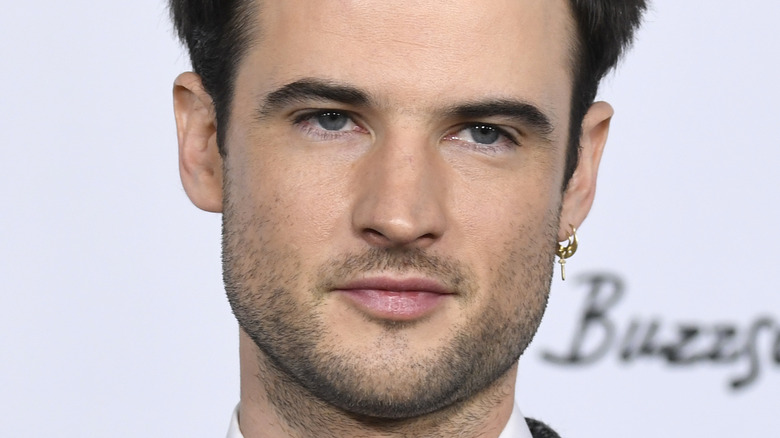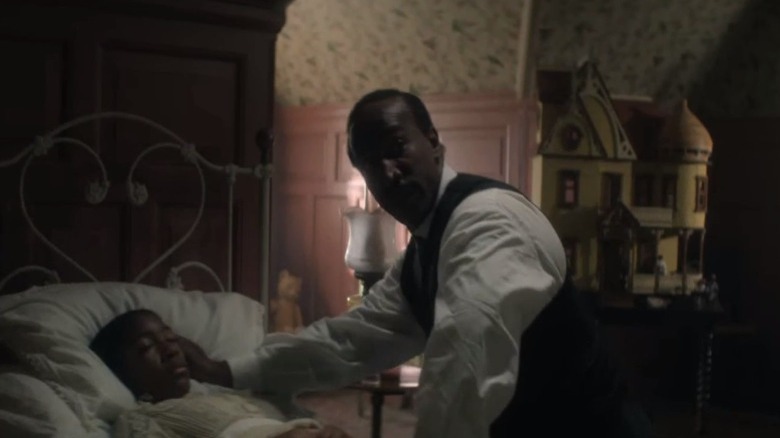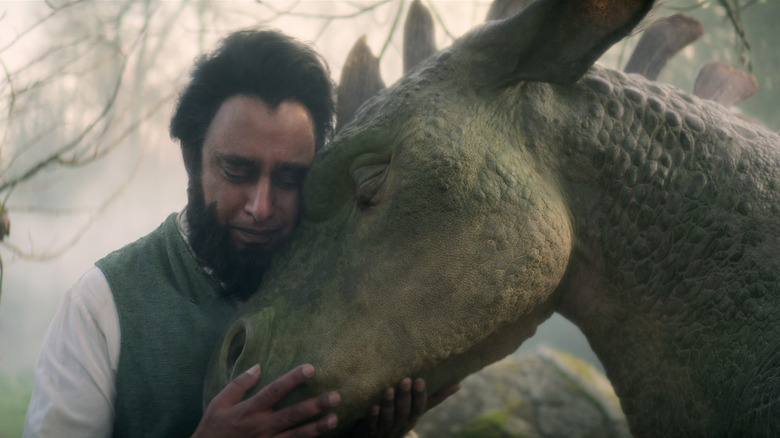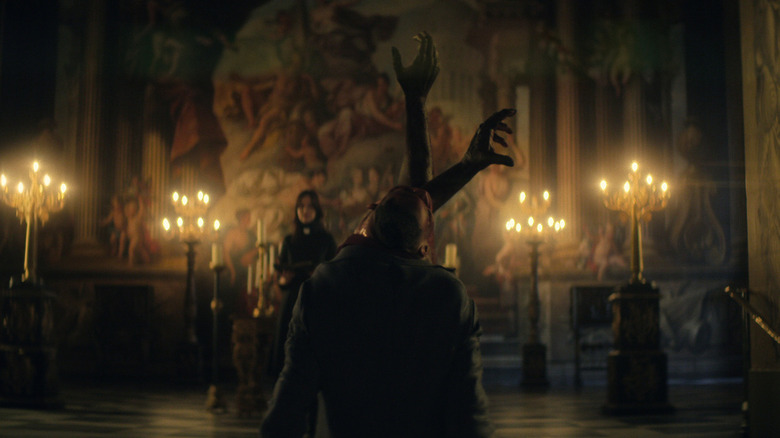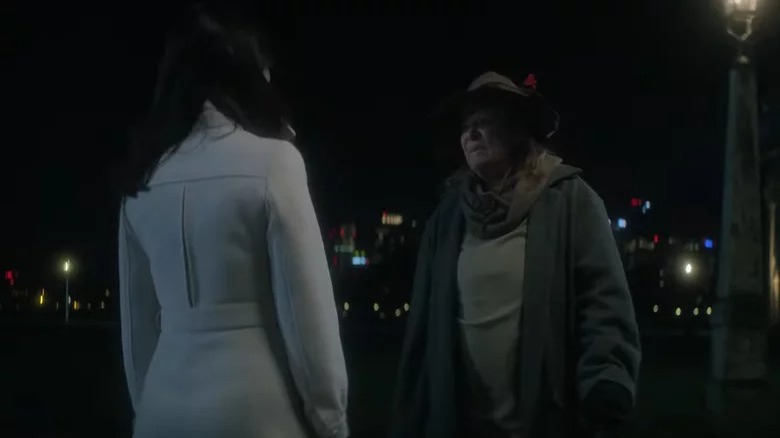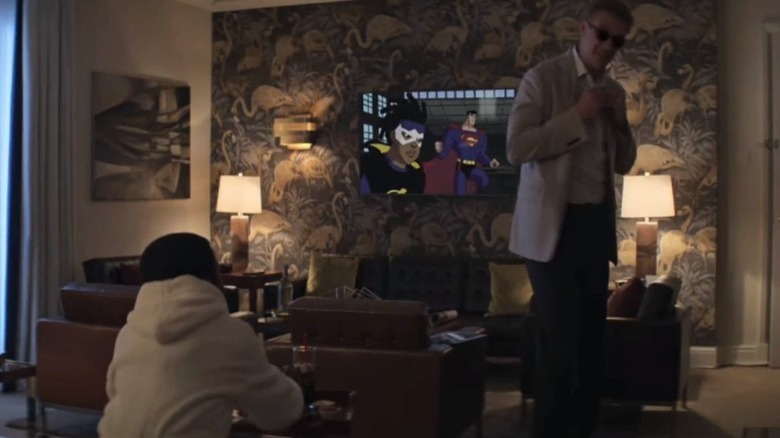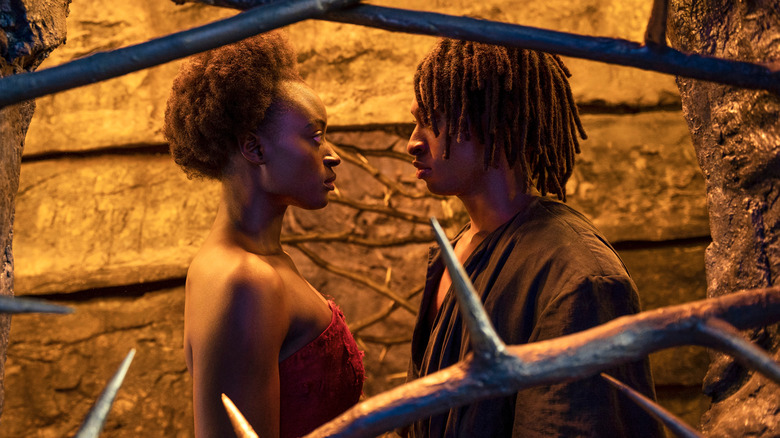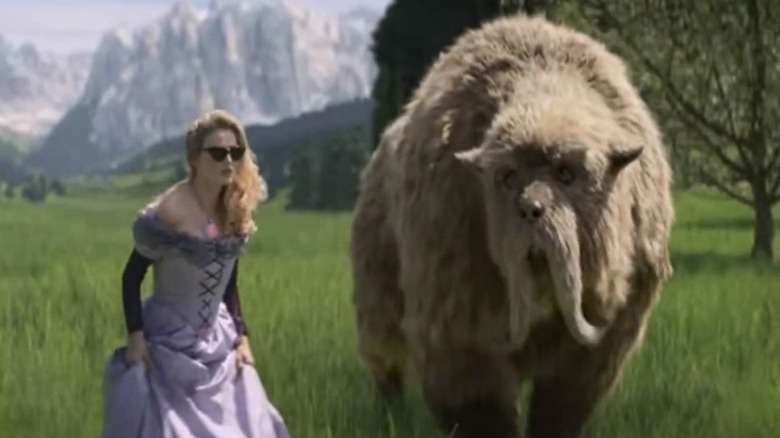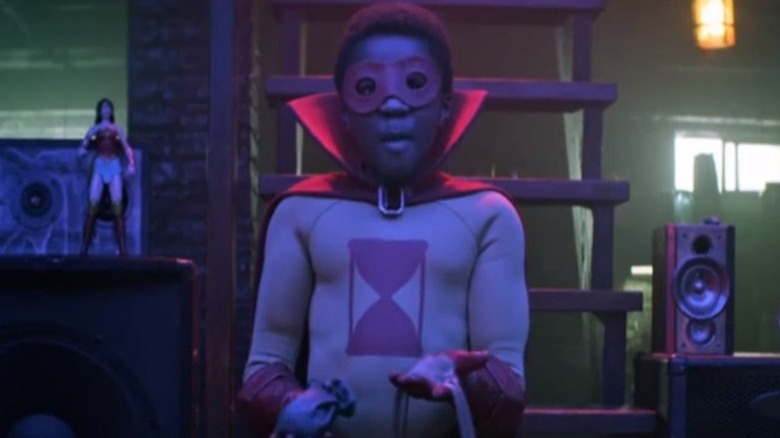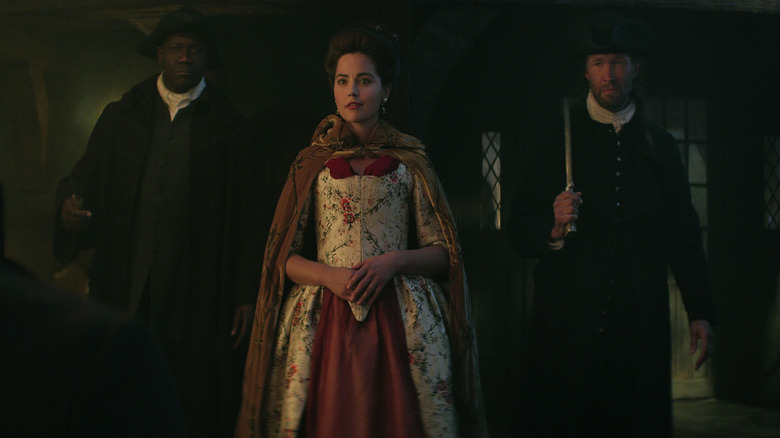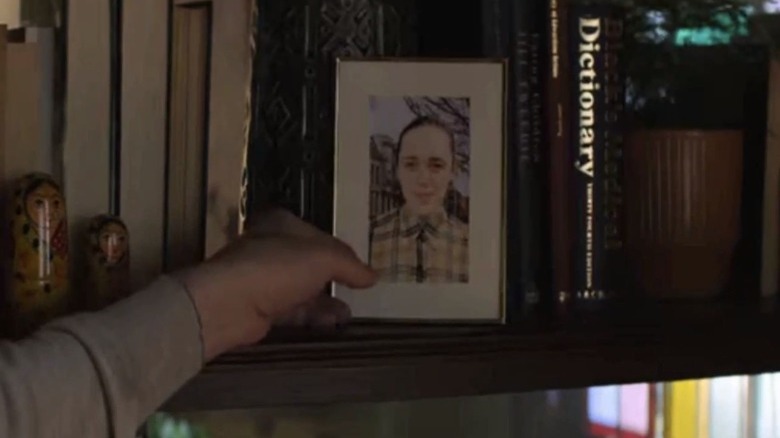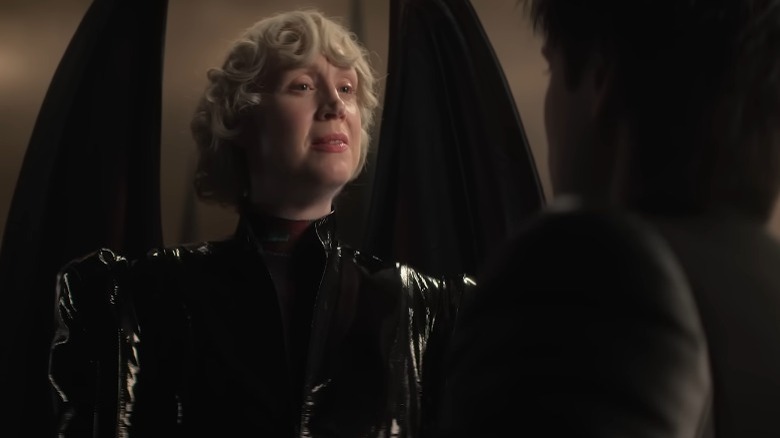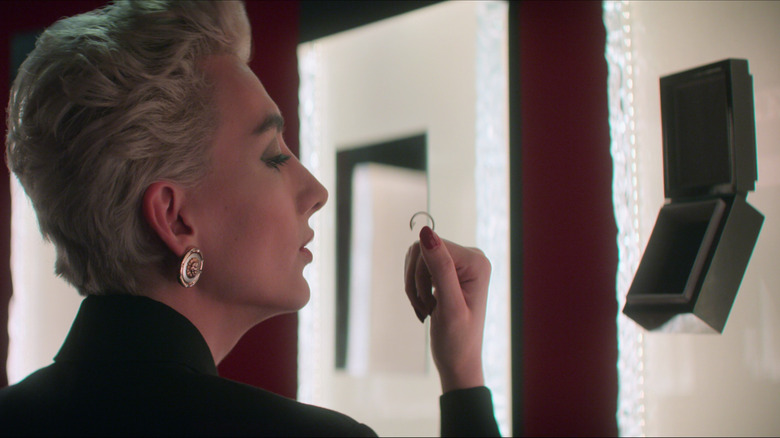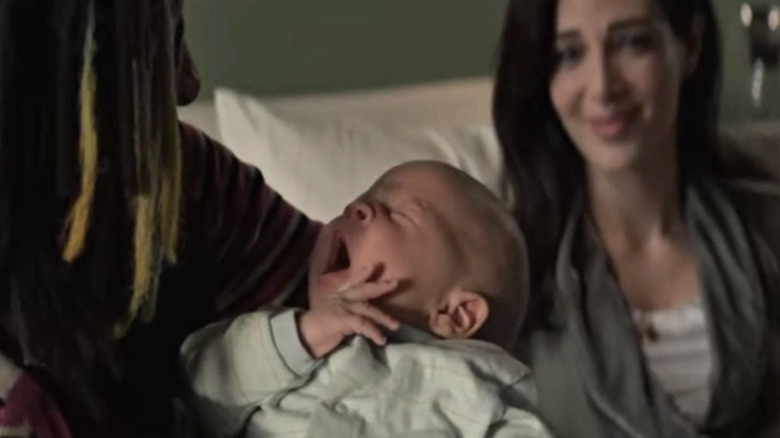Easter Eggs You Missed In The Sandman Season 1
"The Sandman" is one of many DC Comics-Vertigo projects that fought for development into a film or television series for decades, and fans finally got what they hoped for in 2022. Netflix adapted the award-winning comic book series from writer Neil Gaiman, plus Dave McKean and many other artists, into an episodic series. Like a lot of other adaptations, the show is filled with Easter eggs that pay fan service to the people who asked for the adaptation, and there are some good ones.
The first season of "The Sandman" dropped on August 5, 2022, and each of the 10 episodes is an homage to the source material. There's a lot to cover in 75 issues, but every reference or Easter egg isn't limited to that one comic book run. Allusions and references are made to "Hellblazer," "Lucifer," and many other Vertigo titles from the 1980s and '90s. Readers who've loved those books for decades will likely pick up many of the Easter eggs spread throughout the episodes ... but not all of them.
Many small items and plot elements from the books made their way onto the series, and they're not all easy to spot. While viewers are paying rapt attention to one part of the screen, they may miss something elsewhere. Even the most eagle-eyed viewer will miss something, which is why the best Easter eggs you missed in "The Sandman" Season 1 are presented here.
Warning: This article contains spoilers for "The Sandman" Season 1, and as it heavily references the comics, it also contains potential spoilers for the possible Season 2 and beyond.
The sleepy sickness
Neil Gaiman has always been adept at incorporating real-world mythologies and events into his stories. By setting the start of "Sandman" in the first World War, he worked in a real-world event that impacted his story, which was written and ultimately set more than 70 years later. When Dream of the Endless is captured by the occult Lord Magus Roderick Burgess of the Order of Ancient Mysteries, his absence from the Dreaming affects the dreams of all living things.
As Dream says through narration in the episode after his capture, "For the following morning, there were some sleepers who could not wake up. The Sleepy Sickness, as it was called, affected nearly one million men, women, and children in every city, town, and village in the world." He later says, "Some begged for sleep that would not come. Others lived as perpetual sleepwalkers. Most slept without waking."
While this may sound like something that was dreamed up for "The Sandman," it truly happened. Between approximately 1916 and the early 1930s, an epidemic of encephalitis lethargica spread throughout the world. It's believed that more than a million people were afflicted with the bewildering condition, which left people lethargic, comatose, delirious, and more.
Gregory's sacrifice
Gregory's sacrifice in Episode 2 is heartbreaking, yet it shows the level of devotion the nightmares and dreams of the Dreaming have for Lord Morpheus. ("Morpheus" is another name used by the entity known throughout most of "The Sandman" as Dream of the Endless, by the way.) In the episode, Gregory allows himself to be sacrificed to return a fraction of Dream's power to him, making it possible for Dream to travel the dreams of mortals and find offerings to tempt the fates. It's a fantastic scene, but it doesn't align with the comics.
In "Sandman" #2, Dream visits Cain and Abel with Gregory's help. The gargoyle finds the King of Dreams on the edge of the Dreaming and helps him to Abel's doorstep. As in the episode, he asks for Cain and Abel's help, but not Gregory's. Instead, Dream asks for something he created, and Abel happily agrees to hand over his letter of conscription. Cain isn't happy about this, but he begrudgingly hands over his letter as well.
Arguably, the television series handles the sacrifice better than the comics. Making the sacrifice literal for Gregory establishes the stakes and scale of what Dream needs to rebuild his kingdom. It evokes far more emotion from the viewer than Cain and Abel's conscription letters would have.
Johanna Constantine's demon
When we first meet Johanna Constantine, she's on her way to a church to do some light exorcism work under the pretext of officiating a clandestine wedding. When she arrives, instead of telling the would-be couple to recite their vows, she instead speaks the Latin phrases needed to force a demon from the possessed. Things get messy from there.
Once the demon erupts from the man he possessed, Dream arrives and identifies him as Agilieth. They trade some banter, then Johanna completes her spell, forcing the demon back into Hell mid-conversation with Dream, much to our main character's annoyance. Agilieth doesn't appear in "Sandman" comics, but fans of John Constantine may recall him from "Hellblazer." The demon made one appearance in that book, and his part was minor, so hats off to anyone who remembered it right away.
In "Hellblazer" #196, John is freshly unfocused following a recent hypnotism, and he's unable to recover his memories. He stumbles upon a horrific scene where demons sit around a table eating people. At the head is Rosacarnis, who welcomes him, but Agilieth has other ideas. He stands, opposing John despite his host's insistence to sit down. Rosacarnis takes little time to rip the demon apart from the inside, destroying him at John's feet. She quips, "If you eat at my table, you obey my rules," then tells John not to dwell on it, as the servants will clean up the mess.
Mad Hettie
One of the recurring themes of "Sandman" is that everyone gets a single life to live, and then they die and go to another place. For some, it's Hell; for others, it's the Silver City, and those are two examples of many. When a person dies in the Dreaming, they can become a raven — as demonstrated by the existence of Matthew the Raven – but there are other options available should the right circumstances arise. Hob Gadling lucked into immortality by becoming the focus of a bet between Dream and Death, but he's not the only immortal human in the series.
Another is only briefly seen, and that would be Mad Hettie. She tells Johanna Constantine that Morpheus is back, explaining that "He's no fairy story. He's back, and he wants his sand. I know. I'm 208 years old, and I know." Most viewers probably wondered who this woman is and how she could possibly know anything about Morpheus' activities, let alone explain why she was more than two centuries old.
Mad Hettie was born in 1741, and like Mr. Gadling, she didn't think dying was all that interesting of a prospect. To avoid her eventual demise, she hid her heart from Death ... literally. She's been labeled a "witch" over the years and does know some tricks. She pops up occasionally to interact with John Constantine, just as she does with his female counterpart in "The Sandman." Other than offering up her incredible age, she tends to keep her most important secrets to herself.
Jed's TV show of choice
When the Corinthian leaves Jed in the hotel room in Episode 9, titled "Collectors," Jed's watching cartoons on television. If you pay close attention, you see a few characters flash on the screen, revealing that he's watching a "Static Shock" episode titled "Toys in the Hood." The episode isn't on screen simply to advertise another DC television series; it has meaning to the story, and to Jed in particular.
In the episode, the Toyman arrives in Static's hometown of Dakota and attempts to capture Darci, an android woman created by Toyman who developed a mind of her own and seemingly distanced herself from the creepy ne'er-do-well. After Toyman successfully abducts Darci, Static goes searching for her. He's soon joined by Superman and the two team up for the episode. It doesn't take long for the heroes to learn that the Toyman's activities aren't what they appear — he's truly interested in capturing Static's friend Daisy.
Toyman and Darci plan to use Daisy's body as a template so that Darci can be human. Several elements of the cartoon align with Jed's story in "The Sandman." Jed's effectively in Daisy's position, caught between two powerful forces. On the one side, the manipulative Corinthian (Toyman) hopes to use Jed for his nefarious purposes; on the other, Rose (Static) and Gilbert (Superman) are working together to try and save him. Of course, there's more going on, but the crux of the "Static Shock" episode parallels the events of the ninth episode of "The Sandman."
Nada
As Dream and Matthew are being escorted through Hell, they happen upon a woman locked inside a cage. When Dream sees her, the two have a short conversation, and it's clear from their talk that they were once incredibly important to one another. Dream, who Nada knows as "Kai'ckul," observes that they haven't seen each other in 10,000 years. But as we know, he's in Hell on unrelated business.
Dream's response to Nada, "I still love you, but I have not yet forgiven you," is chilling and ripped straight from the comics. The scene might leave viewers wondering how he could be so callous to a woman he loves, and fortunately, there is an explanation in the books. Nada's damnation comes about following a brief love affair. Nada tracks Dream to the Dreaming and confesses her love for him, but she has serious second thoughts after discovering that he's one of the Endless.
After that, Dream follows her to the Waking World and successfully addresses her concerns. While making love on a hill outside her city, a meteorite slams into her home, destroying everyone and everything inside. Distraught, she commits suicide before Dream can stop her. He follows her to her death realm and asks her to return with him. After refusing twice, he tells her if she does it again, he'll damn her to Hell. Eventually he relents and, following an ordeal with a demon, frees her soul and places it in a newborn baby, telling Nada she can return to the Dreaming whenever she wishes.
If you or anyone you know is having suicidal thoughts, please call the National Suicide Prevention Lifeline by dialing 988 or by calling 1-800-273-TALK (8255)
Barbie's dream
When Rose's abilities begin to manifest, she finds herself inside the dreams of her friends. Each dream (and its dreamer) is important to the story, but one stands out from the rest. Barbie's behavior within her dream suggests a degree of familiarity — as if she's experienced it numerous times. Assuming the show keeps following the comics, this should become important to the story following the events of "The Sandman" Season 1. In the dream, Barbie is on a quest with a traveling companion called Martin Tenbones, who mentions something called the "Porpentine."
Barbie's dream, Martin Tenbones, and the Porpentine all set up the comics arc titled "A Game of You." The fairytale-like environs of Barbie's subconscious are layered with complexity and go back to her childhood. She dreams of a magical world called The Land, where she's a deposed princess fighting against the evil abstract being known as the Cuckoo. As Barbie matures, her dream continues, but everything falls apart after she witnesses her husband Ken having sexual relations with a dream woman. Barbie eventually moves to New York City, where she no longer dreams, leaving The Land in disarray.
As The Land crumbles, Martin Tenbones breaks into the Waking World looking for Barbie's help, kicking off "A Game of You," which hopefully "The Sandman" on Netflix will be able to adapt in Season 2 or 3.
The DC Comics connection
It may not be apparent to people watching "The Sandman," but everything going on throughout the comics series happens in the same world as Superman, Batman, and Wonder Woman. The books were published by Vertigo Comics, a now-defunct imprint of DC Comics. Vertigo made it possible for writers and artists to delve into more risqué topics than DC preferred to publish alongside its bread and butter of superhero comics. Regardless, they all came from the same shared universe known as New Earth.
That's the name given to DC Comics' mainstream reality from 1986 until 2011. DC has a habit of reshuffling its realities from time to time, and New Earth sits between two crossover events. "Crisis on Infinite Earths" created New Earth, while "Flashpoint" brought it to an end. That's not something the average viewer of "The Sandman" needs to know, but it does help explain all of the DC Comics Easter eggs seen throughout the series.
The best example would be Jed's dream, where he's a superhero named the Sandman. That's a DC Comics character, and Morpheus is the second to bear the name. Additionally, there are several action figures in Jed's lair, including Batman, the Flash, and Wonder Woman. There are also a few comics strewn about, suggesting Jed is a fan of the Justice League. He also watches an episode of "Static Shock," so there's some DC Comics representation throughout the series.
Lady Johanna Constantine's task
Jenna Coleman's casting as Johanna Constantine is a little bit of a departure from the comics, as this version of Johanna Constantine replaces John Constantine's presence in the comics. Ultimately, they're more-or-less the same character, and Coleman plays a perfectly damaged supernatural sleuth. If you enjoyed seeing her as Johanna Constantine in the third episode, it's something of a treat to see her return in the sixth as the Lady Johanna Constantine, her 18th century ancestor. She and her band of ruffians threaten Morpheus and are quickly dispatched. Later, Morpheus mentions seeing her once more, explaining that she completed a task for him.
If you liked Coleman's performance, she's probably coming back at some point down the line, because Lady Johanna Constantine's task is essential to the overall story. In 1794, Dream calls in a favor she owes him and asks that she rescue his son, Orpheus. Without going into much detail, Morpheus' son was physically ripped apart at one point, but being immortal, he kept existing as a living head, not unlike one of the celebrity heads from "Futurama," for centuries. Orpheus' head was stored in a pile of corpses let over from the French Revolution.
Ultimately, Johanna finds Orpheus' head and returns it to Morpheus, fulfilling the task. This father and son had a rocky relationship, to say the least, but Dream is pleased with Johanna's assistance. After their deal was done, Lady Constantine went on with the rest of her life, ultimately keeping the name going so one day, John Constantine could be born. Lady Johanna lived a long life, dying at the age of 99. Dream had her body interred near Orpheus' temple on the island of Naxos.
Donna
In the fifth episode, "24/7," Judy is introduced as a woman concerned over the likely end of her relationship with Donna. She eventually admits to hitting Donna during a tumultuous fight, and all indications suggest their time together is at an end. The episode then devolves into the nightmare wrought by Dream's ruby, but the name Donna is mentioned throughout the episode. While it's reasonable to assume a person seen or mentioned only briefly in the series isn't important, that's not how things work in "The Sandman."
Later, in the seventh episode, the Corinthian picks up a photograph of Judy in Rose Walker's apartment, showing that the two know one another pretty well. That's the only reference tying the two together in the first season, but far more is revealed in the comics. Donna's full name is Donna Cavanagh, and she doesn't make her first appearance until the 32nd issue, "Slaughter on Fifth Avenue." This is during the "A Game of You" storyline centered on Barbie and her dream.
In the story, Donna's backstory is expanded to explain her relationship with Judy. After Judy's death, she starts going by the name "Foxglove," which she uses in her singer-songwriter career. She's one of the people living with Barbie in New York City, and she ventures into her dream to help rescue Barbie from the Cuckoo.
Lucifer's Plan
Dream ventures into Hell with as much respect for Lucifer as possible, but things didn't work out as perfectly as Lord Morpheus would have liked. He embarrasses Lucifer in Hell and in front of every demon, which didn't sit too well with the Morningstar. After Dream leaves, Lucifer promises to do something totally unprecedented. According to Lucifer, that something will "make God absolutely livid and bring Morpheus to his knees."
This probably left a few viewers wondering what Lucifer's plan might be. If things play out as they did in the comics — and the series has kept incredibly close to the source material so far — Lucifer's plan is well known. In the books, Dream returns to Hell to forgive Nada, but he finds Hell empty. Only Lucifer remains and is moving about, finding any lost souls or demons remaining in damnation. Lucifer explains that it was time to quit being the Lord of Hell, and it's time for retirement.
Dream helps to cut off Lucifer's wings and is left holding the key to Hell. This was Lucifer's plan — to saddle Dream with the burden of damnation, which presents all manner of problems for Morpheus. Lucifer explains that it was Dream who provided the impetus to abdicate. Handing Dream the key, Lucifer reminds him of the erstwhile vow to destroy the Dream Lord, explaining, "Perhaps it will destroy you, and perhaps it won't. But I doubt it will make your life any easier."
(Side note: It doesn't.)
The Endless
The "Sandman" comics go into detail regarding the nature of the Endless, who they are, and what they do. The Netflix series doesn't do this in the first season, only offering a small sampling of the Endless with depictions of Dream, Death, Desire, and Despair. Death puts it best when she admonishes her little brother, stating, "You are utterly the stupidest, most self-centered, pathetic excuse for an anthropomorphic personification on this or any other plane!" That's what the Endless are — anthropomorphic personifications of natural forces.
The Endless are the masters of their own domains, and Dream's is called the Dreaming. There are others each member of the family rules over, though Dream's is the one most often visited by sentient beings, including humans. Everyone meets Death (with few exceptions) but that happens only once. Meanwhile, everyone spends a third of their lives in Dream's realm, making him incredibly important.
Each member of the Endless, all of whom are children of Night and Time, have a gallery within their realms. It's from the gallery that they contact one another by holding their sigil and asking for an audience. Only Destiny can compel his siblings to a meeting, whereas the rest must make a request. The family consists of seven members. In addition to Dream, Death, Desire, Despair, and Destiny, there's Delirium (previously known as Delight), and Destruction. If you pay attention to the galleries in the series, you'll notice one portrait remains empty.
The Prodigal
At several points throughout the first season of "The Sandman," various members of the Endless mention someone they call "the Prodigal." It's never explained who they're referring to, but it's something you can figure out whether you've read the comics or not. The name itself is a clue, as "prodigal" means a son or daughter who abandons his familial obligations to set out on their own. Knowing this and seeing an empty portrait in Dream and Desire's galleries, it's clear the Prodigal is one of the Endless.
Only three Endless who haven't shown up in the series remain: Destiny, Delirium, and Destruction. The comics reveal that the Prodigal is Destruction, who goes by the name Olethros. He is the only member of the family to abandon his post, leaving his responsibilities behind. This is why the Endless refer to him as "Prodigal," and it's also why his portrait doesn't hold a sigil in anyone's galleries. When he finally turns up, his sigil remains in his portrait in his gallery.
Destruction's purpose is to destroy so new things can be created, but he abandoned his responsibilities when mankind turned towards science. Knowing humanity would make new and horrific means of destruction, Destruction opted to walk away, which he did sometime around the 17th century. He fell off his siblings' radars and traveled with a talking dog named Barnabas. He remained unwavering in his decision when he resurfaced, though he gave Barnabas to Delirium.
Lyta's son
When Rose Walker leaves the Dreaming, she awakens to learn that Lyta has given birth to a son. She meets the baby, but the child doesn't have a name. Of course, the comics spell it all out for you, and to be clear, the child is incredibly important to the story and Dream's fate. Massive spoilers ahead.
In the comics, the boy is called Daniel Hall, and as you probably remember, Dream insisted the baby was his. This doesn't sit well with Rose or Lyta, but it's not expanded upon, leaving many wondering what he's talking about.
Daniel was created inside the Dreaming, making him part of Dream's domain. He's the son of Hector Hall (Doctor Fate in the comics) and Lyta, but he's destined for something more. Dream is the one who names Lyta's son Daniel, which she likes despite his insistence on one day returning to take him from her. It doesn't take long for Daniel to manifest an ability to enter the Dreaming in a manner far more lucid than most dreamers, where he meets Cain and Abel and enjoys their stories.
Ultimately, Lyta loses her sanity and seeks out the Furies to mete out their form of justice on Dream. This results in two things happening: Dream is ultimately destroyed by the Furies for the crime of killing his only son, Orpheus, and her action also leaves the role of Dream of the Endless open. Daniel artificially ages, becoming the new manifestation of Dream.
